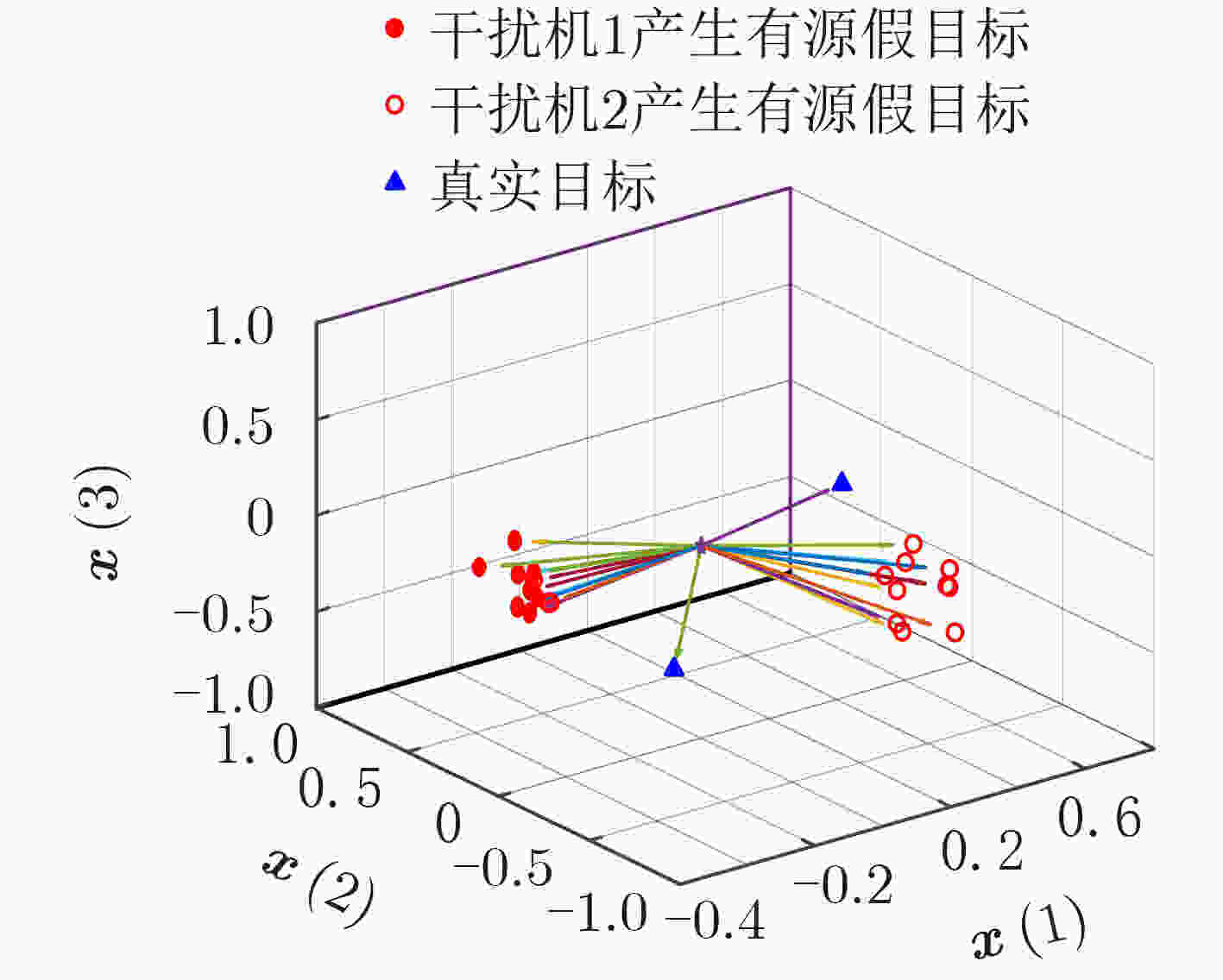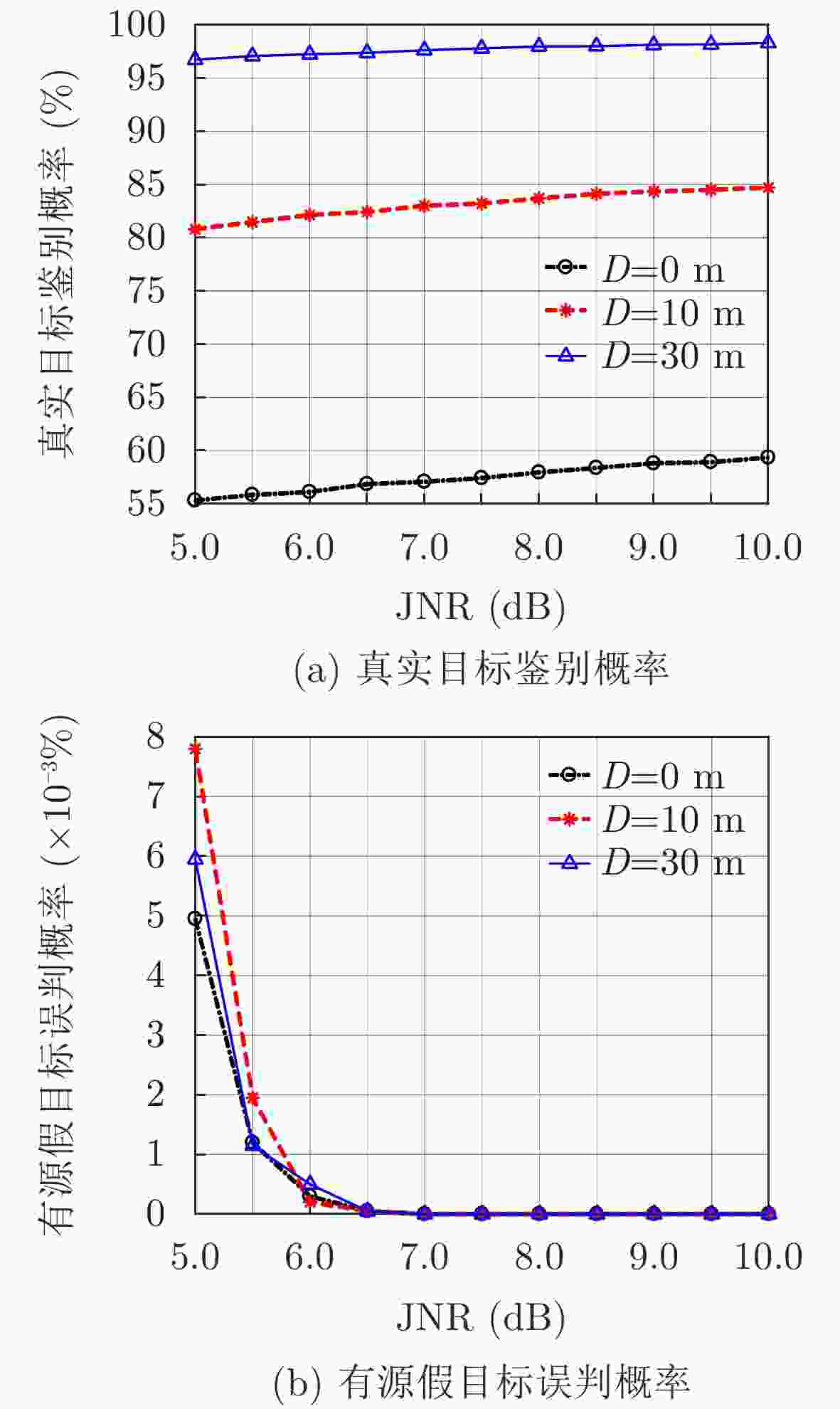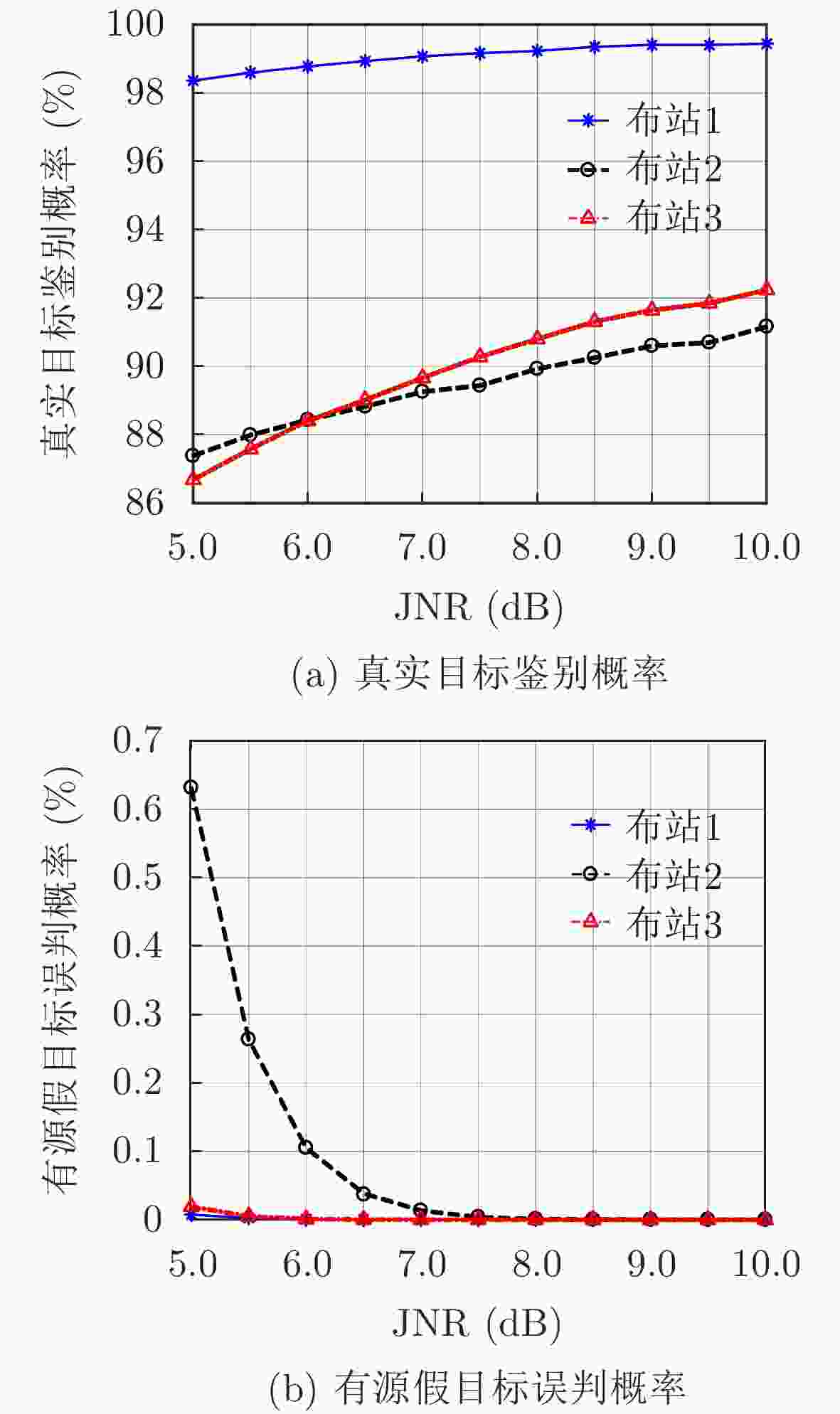Clustering Method to Discriminate Active False Targets in Multistatic Radar System
-
摘要: 针对现有多基地雷达抗欺骗式干扰方法无法应用于多干扰源的问题,该文提出一种基于聚类分析的多基地雷达鉴别有源假目标方法,利用真假目标接收信号矢量之间相关性的差异,以相关系数为度量,通过聚类分析方法,将相同干扰源产生的假目标聚为一类,每个真实目标各为一类,实现有源假目标的有效鉴别。该方法可用于鉴别任意欺骗调制方式产生的有源假目标,且适用于多个干扰源实施分布式干扰的应用场景。最后,通过仿真实验,验证了所提聚类分析方法鉴别有源假目标的有效性。Abstract: The available deception anti-jamming methods in multistatic radar can not be applied to multiple jamming sources. In view of this problem, a clustering analysis-based method is proposed to discriminate active false targets in multistatic radar, according to the differences in the correlation between the received signal vectors of true and false targets. Measured by the correlation coefficient in clustering analysis method, the false targets generated by the same jamming source are grouped into one cluster, while each true target constitutes one singleton cluster, achieving the effective discrimination of active false targets. The proposed method can be used to discriminate active false targets generated by any deception modulation mode and is suitable for the application of distributed jamming with multiple jamming sources. Finally, the effectiveness of the clustering analysis method to discriminate active false targets is verified through simulation experiments.
-
表 1 多基地雷达布站(m)
序号 发射站 接收站 布站1 [0, 0], [300, 0] [–500, 0], [–250, 0], [0, 0], [250, 0], [500, 0] 布站2 [0, 0] [–500,0], [–250,0], [0,0], [250,0], [500,0] 布站3 [0, 0], [300, 0] [–250, 0], [–125, 0], [0, 0], [125, 0], [250, 0] -
[1] POISEL R A. Information Warfare and Electronic Warfare Systems[M]. Boston: Artech House, 2013. [2] WU Chuanzhang and CHEN Baixiao. A recognition algorithm of VGPO jamming based on discrete chirp-Fourier transform[J]. EURASIP Journal on Advances in Signal Processing, 2020, 2020: 37. doi: 10.1186/s13634-020-00694-3 [3] YU Hengli, ZHANG Juan, ZHANG Linrang, et al. Polarimetric multiple-radar architectures with distributed antennas for discriminating between radar targets and deception jamming[J]. Digital Signal Processing, 2019, 90: 46–53. doi: 10.1016/j.dsp.2019.03.012 [4] 文才, 王彤, 吴亿锋, 等. 极化-空域联合抗机载雷达欺骗式主瓣干扰[J]. 电子与信息学报, 2014, 36(7): 1552–1559. doi: 10.3724/SP.J.1146.2013.01739WEN Cai, WANG Tong, WU Yifeng, et al. Deceptive mainlobe jamming suppression for airborne radar based on joint processing in polarizational and spatial domains[J]. Journal of Electronics &Information Technology, 2014, 36(7): 1552–1559. doi: 10.3724/SP.J.1146.2013.01739 [5] CHERNYAK V S. Fundamentals of Multisite Radar Systems: Multistatic Radars and Multi-radar Systems[M]. London: CRC Press, 1998: 44. [6] BUTT F A, NAQVI I H, and NAJAM A I. Radar ECCM against deception jamming: A novel approach using bi-static and mono-static radars[C]. 2012 15th International Multitopic Conference, Islamabad, Pakistan, 2012: 137–141. doi: 10.1109/INMIC.2012.6511482. [7] 于恒力, 张林让, 刘洁怡, 等. 一种异构组网雷达系统抗欺骗式假目标方法[J]. 电子科技大学学报, 2019, 48(5): 706–710. doi: 10.3969/j.issn.1001-0548.2019.05.007YU Hengli, ZHANG Linrang, LIU Jieyi, et al. A method against deception-false-target jamming based on isomerous netted radars[J]. Journal of University of Electronic Science and Technology of China, 2019, 48(5): 706–710. doi: 10.3969/j.issn.1001-0548.2019.05.007 [8] ZHAO Shanshan, ZHANG Linrang, ZHOU Yu, et al. Discrimination of active false targets in multistatic radar using spatial scattering properties[J]. IET Radar, Sonar & Navigation, 2016, 10(5): 817–826. doi: 10.1049/iet-rsn.2014.0147 [9] 孙闽红, 丁辰伟, 张树奇, 等. 基于统计相关差异的多基地雷达拖引欺骗干扰识别[J]. 电子与信息学报, 2020, 42(12): 2992–2998. doi: 10.11999/JEIT190634SUN Minhong, DING Chenwei, ZHANG Shuqi, et al. Recognition of deception jamming based on statistical correlation difference in a multistatic radar system[J]. Journal of Electronics &Information Technology, 2020, 42(12): 2992–2998. doi: 10.11999/JEIT190634 [10] ZHAO Shanshan, LIU Nan, ZHANG Linrang, et al. Discrimination of deception targets in multistatic radar based on clustering analysis[J]. IEEE Sensors Journal, 2016, 16(8): 2500–2508. doi: 10.1109/JSEN.2016.2516000 [11] ZHAO Shanshan, ZHOU Yu, ZHANG Linrang, et al. Discrimination between radar targets and deception jamming in distributed multiple-radar architectures[J]. IET Radar, Sonar & Navigation, 2017, 11(7): 1124–1131. doi: 10.1049/iet-rsn.2016.0540 [12] SUI Mingyan, ZHOU Peng, WANG Ying, et al. . Verification of compensation accuracy of high precision time and phase synchronization algorithms based on bidirectional synchronization chain[C]. 2019 6th Asia-Pacific Conference on Synthetic Aperture Radar, Xiamen, China, 2019: 1–6. doi: 10.1109/APSAR46974.2019.9048368. [13] 赵珊珊, 张林让, 李强, 等. 分布式多站雷达转发式欺骗干扰研究[J]. 电子与信息学报, 2017, 39(1): 138–143. doi: 10.11999/JEIT160118ZHAO Shanshan, ZHANG Linrang, LI Qiang, et al. Research on repeater jamming against distributed multiple-radar system[J]. Journal of Electronics &Information Technology, 2017, 39(1): 138–143. doi: 10.11999/JEIT160118 [14] ZHOU Shenghua, LIU Hongwei, ZHAO Yongbo, et al. Target spatial and frequency scattering diversity property for diversity MIMO radar[J]. Signal Processing, 2011, 91(2): 269–276. doi: 10.1016/j.sigpro.2010.07.004 [15] XU Rui and WUNSCH II D C. Clustering[M]. Hoboken: Wiley, 2009: 74–76. [16] VIJAYA, SHARMA S, BATRA N. Comparative study of single linkage, complete linkage, and ward method of agglomerative clustering[C]. 2019 International Conference on Machine Learning, Big Data, Cloud and Parallel Computing, Faridabad, India, 2019: 568–573. doi: 10.1109/COMITCon.2019.8862232. -






 下载:
下载:





 下载:
下载:
